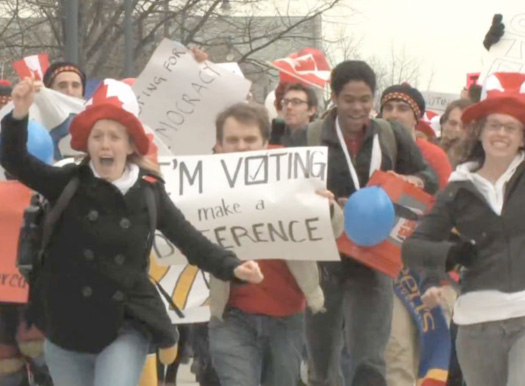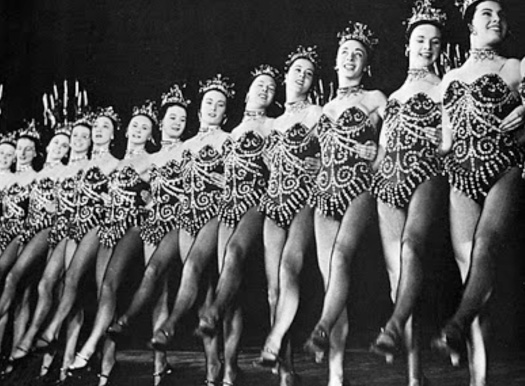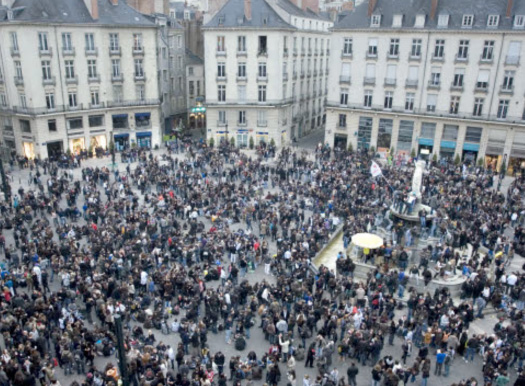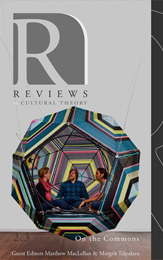In the lead up to the 2011 Canadian federal elections, thousands across Canada participated in a wave of over fifty “vote mobs” aimed at counteracting the widespread image of apathy and disengagement of young people from the electoral process. These vote mobs involved dozens to hundreds of people gathering together on university campuses and other public spaces to celebrate voting, mostly through dancing, singing, chanting and running around in front of a video camera, occasionally dressing up in the colours of the Canadian flag. The media reaction to these mobs reflects the contradiction at the level of the “vote mob” designation itself. The phrase straddles two concepts that in liberal political theory have often been counter-posed. On the one hand, voting is understood as the fundamental activity of political participation, citizenship, and identification with the representative institutions of parliament. The mob, on the other hand, is perceived as a dangerous, because uncontrollable, entity that threatens to undermine the rule of law and which risks becoming violent and destructive. The first concept privileges the notion of the individual who makes presumably rational choices, while the second invokes the image of an irresponsible and irrational collective, susceptible to emotional manipulation and prone to unpredictable outbursts.
When asked about the voting “flash mobs” at a press conference, Conservative MP John Baird responded by saying that he found the terms “disconcerting” and didn’t like the “context of either word.” Michael Taube, writing for the Ottawa Citizen, first displayed cynicism that the vote mobs would result in actual votes, and then fear at the prospect of it actually working. Taube makes the assumption that the people taking part in vote mobs are of the “circus clown variety,” likely radicals, and uninformed about politics (Ottawa Citizen, 2011). He therefore concludes that while an increased voter turnout on their part would be good for democracy, it would be bad for “political stability.” In short, Taube’s comments nicely illustrate an understanding of democracy that it is premised on the exclusion of broad masses of the population in order to function smoothly. While belief in the system is necessary, too much involvement is counter-productive to beneficial political outcomes, as determined by an elite of informed experts.

Supporters of the vote mobs, such as comedian Rick Mercer (who is credited with provoking their emergence) focused on the non-partisan positivity of the events, and the warm feelings produced by the videos. In an interview on Canadian television broadcaster CTV, Mercer also explicitly contrasted vote mobs with the “negativity” of the stereotypical mob and overtly political protests (April 18, 2011). The vote mobs are presented as doing an old thing in a new way. They express involvement with traditional parliamentary structures and gentle patriotism, but are presented in a form that is engaging to young people.
While the content of vote mobs certainly presents a banal patriotism and the reiteration of a non-partisan “get out there and vote” message, it is precisely the form of engagement that makes them irreducible to the traditional social formations invested in parliamentary structures (those of political parties and the social movements that try to influence them). Vote mobs must be situated in relation to an emergent crowd culture that is neither violent and destructive, nor oriented towards democratic institutions and political causes. They number among various crowd formations that have recently come into existence and that manifest a desire for a new kind of common experience.
Writing in the nineteen-twenties, Siegfried Kracauer pointed to one such spectacular crowd formation that he referred to as the mass ornament (1995). What he had in mind, in particular, was a popular style of performance that became epitomized by the Tiller Girls, a group of young women dancers who dressed and moved identically in linear formations. Kracauer was fascinated by the mass ornament as an empty form or end in itself and how it reflected the limits or irrationality of capitalist reason. He wrote:
It is the rational and empty form of the cult, devoid of any explicit meaning, that appears in the mass ornament. As such, it proves to be a relapse into mythology of an order so great that one can hardly imagine its being exceeded, a relapse which, in turn, again betrays the degree to which capitalist Ratio is closed off from reason. (1995: 84)
What is interesting in Kracauer’s reflections is that the irrationality and the empty meaninglessness of the mass ornament is derived from capitalist rationality itself. Following Weber’s critique of technocratic rationality, and anticipating Horkheimer and Adorno’s writings on the dialectic of enlightenment, Kracauer locates mythology in the spectacular fetishization of form. The mass of performers, mirrored in the mass audience, does not become irrational or dangerous due to its being swayed by emotion (which is clearly lacking in the shallow, repetitive performances) nor in the influence of a great leader (since the spectacle is multitudinous

there is no central figure that rises above the crowd). It is the emphasis on form for its own sake, deprived of ends or meaning, that becomes the vehicle for destruction. The consequences of this irrational drive of capitalist reason is not property destruction and street brawls, but rather, property itself and the diffuse symbolic violence that is produced in the form of social inequality.
Today, entertainment that draws its appeal from the spectacular repetitive and abstract movement of crowds can be found on a smaller and more participatory scale in flash mob performances. In flash mobs, social networking sites are used to gather large groups who surprise bystanders by performing a repetitive action in synchrony. Alongside these gatherings that emphasize the synchronicity of movement are crowds that are satisfied with a synchronicity of presence. I include here deviations from the classic flash mob that are geared towards greater social interaction such as metro parties, silent raves, zombie walks, and the apéro géant. The last of these are huge gatherings, popular in France, in which thousands and even tens of thousands of people converge on a public park or square, sit on checkered blankets, and partake in the French late-afternoon tradition of l’aperitif (the consumption of alcohol). The apéro géants are notable in that they are conceived by participants as a competition between cities to see who can gather the most people. The drive towards scale pushes the meaning of the event away from social interaction towards the simple knowledge of an enormous co-presence.
Unlike typical crowds, these friendly gatherings are disconnected from organizations, political causes, or mass entertainment such as sporting events, music concerts, or community festivals. As a result, they are unorganized in the strict sense of having accountable individuals who make decisions, and are highly participatory. People seem to bask in “groupiness” without qualification as to group identity or event meaning. And while participants are not clearly distinguished between audience and performers, the events are also imbued with spectacle. A participatory mode of spectatorship allows people to occupy both roles, providing them with a chance to disappear into a mass and reappear as a part of a larger image, one that cannot be perceived from within, but only through the mediation of visual technologies. Bird’s-eye-view

Apéro géant, Nantes May 14, 2010
photographs of the immense crowds are captured and uploaded onto the Internet, from whence the event originated. With these images, participants can revel in the surface effects of this mass creation that replaces meaning with an endless repetition of form.
While the need for being-together has been typically expressed by youth through involvement in subcultures and smaller social gatherings in clubs, cafés, shopping zones, etc, these contemporary crowds are set apart by a distinctive drive towards size. They indicate a desire to be part of a group that is so large that there is no way that one could actually interact with everyone present. In fact, interaction seems to be fairly low on the agenda. Also notable is that many of these gatherings take place in broad daylight in public places, a quality that distances them from being understood as a part of rave culture or nightlife culture where people typically attempt to let off steam, are more prone to transgress, and seek escape from the “daily grind.” I would argue that these crowds indicate a desire on the part of participants to be part of a more general public culture. They would seem to be less about occasions to distinguish oneself from the mainstream, or to seek out alternative spaces, than they are a claim on a universal kind of togetherness: the production of a public.
Vote mobs display some elements of synchronous movement planned and executed by participants during the events. The geometric and repetitive movements of the classic flash mob are downplayed, however, as people revel in the simple fact of their co-presence within the crowd. If we understand vote mobs as being a part of this emerging crowd culture, their attachment to the political institution of voting may strike us as exceptional. What ground for politics is generated in this social space? One central attribute that is common to these crowds is an explicit rejection of markers of difference, identity, or antagonistic stance towards institutions. While differences certainly exist, these crowds constitute themselves by making tacit rather than explicit the fact of one’s political identifications. Any truly political claim that would necessarily result in antagonism is implicitly rejected. The ground for assembling is not a cause, but a lack of one.
We might contrast these meaningless yet peaceable crowds with more destructive recent trends in mobbing. In 2005, marginalized immigrants took to the streets of the banlieus of Paris to burn and damage property in their own neighbourhoods. What was intriguing about these incidents was that no direct cause could be seen to have instigated the rioting. Slavoj iek described the riots as a “‘zero level’ protest, a violent protest act which ‘wants nothing.’” (2007: 12-29) What was troubling about this revolt was the inability on the part of the protestors to articulate specific political demands, let alone a meaningful social project. Rather than try to impose a politics on the outburst from the outside, for example, by pointing to the marginal socio-economic status of the protestors, iek claims that we should recognize the riots as a demand for visibility. This desperate need for visibility was not about the recognition of some ethnic or religious difference, but a desire to be seen as a part of the whole of French society. He understands this desire as a symptom of the lack of cognitive mapping in late-capitalist society. Following iek, we might understand the dis-identification at play in recent crowd formations as indicative of a broad collapse of belief structures in the contemporary world. In this context, to associate oneself with an explicit cause might be perceived as naïve and outmoded. Perhaps the non-partisan call to vote fits within an apolitical rubric of togetherness precisely because it posits parliamentarism as a ground of consensus, and not one of antagonism. If anything, vote mobs give some indication of the extent to which the capitalo-parliamentary institutions and the corporate media have succeeded in depoliticizing the social imaginary. Being together enters this situation as a compensatory symptom of a more fundamental worldlessness, a condition that will not go away after a few martinis.
Works Cited
“Interview with Rick Mercer.” CTV Question Period. April 18, 2011. Television.
Kracauer, Siegfried. “The Mass Ornament.” The Mass Ornament: Weimar Essays. Ed. Thomas Y Levin. Cambridge: Harvard University Press, 1995. Print.
Taube, Michael. “Vote Mob Mentality.” Ottawa Citizen [Ottawa], 22 April, 2011. Print.
iek, Slavoj. “Some Politically Incorrect Reflections on Urban Violence in Paris and New Orleans and Related Matters.” Urban Politics Now: Re-Imagining Democracy in the Neoliberal City. Ed. BAVO. Rotterdam: NAi Publishers, 2007. Print.
